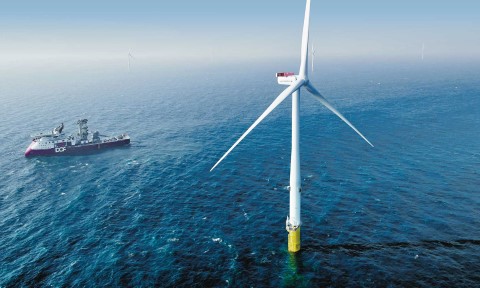Vattenfall has decided to further increase its emission reduction targets for 2030 and beyond, aiming to reach net zero by 2040. The new targets are set to help keep the global warming at a maximum of 1.5 degrees Celsius and have been approved by the Science Based Targets initiative, SBTi, providing external validation in line with the latest climate science research. Vattenfall is now one of the few leading energy companies that have taken this critical step.
In October 2019,Vattenfall’s climate targets were approved by the SBTi to be in line with the 2 degrees Celsius trajectory. Now Vattenfall has decided to take another step to reduce emissions even further, aligning with the 1.5 degrees scenario, the most ambitious scenario of the Paris Climate Agreement.
“The climate crisis is for real and not only do we have a responsibility to step up and move fast, we also see many opportunities for us at Vattenfall in being a leader in this urgent transition. That is why we at Vattenfall have committed to take action in accordance with IPCC’s conclusions. Achieving 2 degrees is not enough. The 0.5-degree difference means the world to us and is a huge step towards a fossil free living within one generation,” says CEO and President at Vattenfall Anna Borg.
Anna Borg adds: “Already in 2020, we achieved our 2 degrees SBTi target of reducing absolute CO2 emissions by nearly 40% from 2017, ten years ahead of schedule. Now we will continue our accelerated path. This means we will reduce our emissions intensity by over 77% from 2017 to 2030. We also commit to a Net Zero by 2040 target, meaning we will achieve net zero emissions in our full value chain by 2040. It is important that we use our expertise and position in the market to help our customers and suppliers to decarbonise, which is why we also have set a 50% emission reduction target for our suppliers of goods and services.”
Alberto Carrillo Pineda, Managing Director and Co-Founder of the SBTi, comments: “We are delighted that Vattenfall, one of Europe’s leading energy companies, has taken this bold step and is amongst few European energy companies that have committed to lowering their emissions along the 1.5-degree trajectory. We look forward to seeing the results of this new ambition.”
Comprehensive measures are needed
Vattenfall’s ambitions to reach its 2030 commitment are:
- phase out coal from all operations by switching the last two coal-fired heat assets, Moabit and Reuter West in Berlin, to a combination of biomass, heat pumps, power-to-heat, and natural gas
- add four times the capacity of wind and solar to the grid compared to what Vattenfall has now in operations
- help partners and society to electrify industrial processes, including in steel, cement, heavy transport, chemicals, and more, enabling emissions reductions beyond Vattenfall’s own value chain
- have 25 times as many electric charging points in operation, compared to 2020
“Phasing out coal represents the next phase of our decarbonisation journey: we’ve gone from more than 22 million tons of CO2 in 2017 to about 12 million tons in 2020, and these new investments will give us a flexible, future-proof portfolio of assets that will reduce emissions to under 6 million tons in 2030 and will contribute to net zero operations by 2040,” says Annika Ramsköld, Head of Sustainability at Vattenfall.
Vattenfall has also committed to being net zero along its full value chain in 2040, meaning that in 2040, the company’s steeper decarbonisation trajectory will have continued and all CO2 emissions from the whole value chain, including emissions from suppliers and customers, will either have been eliminated or offset via negative emissions.
Vattenfall’s new emission reduction targets:
- Reduce emissions intensity in the company’s operations (Scope 1+2) by more than 77% by 2030 compared to 2017 (SBTi approved)
- Reduce absolute emissions from use of sold products (Scope 3) by 33% by 2030 compared to 2017 (SBTi approved)
- Reach net zero by 2040
About SBTi:
SBTi is a joint initiative between CDP1, the UN Global Compact, WRI2 and WWF. The collaboration provides a methodology that specifies how much and how quickly companies need to reduce their greenhouse gas (GHG) emissions in order to meet the goals of the Paris Agreement to limit global warming to well below 2 degrees above pre-industrial levels and pursue efforts to limit warming to 1.5 degrees.
1: CDP = Carbon Disclosure Project
2: WRI = World Resources Institute.
| Vattenfall’s major milestones in reducing carbon dioxide emissions since 2017 include: – 2018: Halving of carbon dioxide emissions in Berlin (compared to 1990), three years ahead of agreement with City of Berlin – 2019: Closure of coal-fired plant Hemweg 8 in Amsterdam. Yearly CO2 reduction approx. 2.5 Mton – 2019: Opening of 120 MW Power-to-Heat plant in Berlin, enabling phase-out of coal plant Reuter C – 2020: Closure of coal-fired CHP Moorburg in Hamburg. Yearly CO2 reduction approx. 5 Mton – 2020: Opening of gas-fired CHP Marzahn in Berlin. Yearly CO2 reduction approx. 240 kton |


